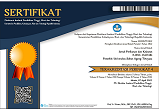PENGARUH PEMBERIAN BIOFLOK SEBAGAI PAKAN TAMBAHAN TERHADAP PERFORMA PRODUKSI IKAN LELE DUMBO (Clarias gariepinus)
Abstract
Keywords
Full Text:
PDFReferences
AftabUddin S, Siddique MAM, Sein A, Dey PK, Rashed-Un-Nabi M, Haque MA. 2020. First use of biofloc technology for Penaeus monodon culture in Bangladesh: Effects of stocking density on growth performance of shrimp, water quality and bacterial growth. Aquaculture Reports, 18, 100518. https://doi.org/10.1016/j.aqrep.2020.100518
Anand PSS, Kohli MPS, Kumar S, Sundaray JK, Roy SD, Venkateshwarlu G, Sinha A, Pailan GH. 2014. Effect of dietary supplementation of biofloc on growth performance and digestive enzyme activities in Penaeus monodon. Aquaculture, 418–419, 108–115. https://doi.org/10.1016/j.aquaculture.2013.09.051
AOAC. 2005. Association of Officiating Analytical Chemestrys 18th edition (18th ed.). AOAC International.
Bakar NSA, Mohd Nasir N, Lananan F, Abdul Hamid SH, Lam SS, Jusoh A. 2015. Optimization of C/N ratios for nutrient removal in aquaculture system culturing African catfish, (Clarias gariepinus) utilizing Bioflocs Technology. International Biodeterioration and Biodegradation, 102, 100–106. https://doi.org/10.1016/j.ibiod.2015.04.001
Dauda AB. 2020. Biofloc technology: a review on the microbial interactions, operational parameters and implications to disease and health management of cultured aquatic animals. Reviews in Aquaculture, 12(2), 1193–1210. https://doi.org/10.1111/raq.12379
Effendie, M. I. 1979. Metode biologi perikanan (1st edition). Yayasan Dwi Sri Bogor.
Ekasari J, Angela D, Waluyo SH, Bachtiar T, Surawidjaja EH, Bossier P, De Schryver P. 2014. The size of biofloc determines the nutritional composition and the nitrogen recovery by aquaculture animals. Aquaculture, 426–427, 105–111.
Ekasari J, Pasha HK, Priyoutomo NB. 2018. Utilization of biofloc meal as a feed ingredient for Nile tilapia and Common carp. Jurnal Akuakultur Indonesia, 17(1), 9. https://doi.org/10.19027/jai.17.1.9-15
Emerenciano M, Ballester ELC, Cavalli RO, Wasielesky W. 2011. Effect of biofloc technology (BFT) on the early postlarval stage of pink shrimp Farfantepenaeus paulensis: growth performance, floc composition and salinity stress tolerance. Aquaculture International, 19(5), 891–901. https://doi.org/10.1007/s10499-010-9408-6
Fischer H, Romano N, Renukdas N, Egnew N, Sinha AK, Ray AJ. 2020. The potential of rearing juveniles of Bluegill, Lepomis macrochirus, in a biofloc system. Aquaculture Reports, 17, 100398. https://doi.org/10.1016/j.aqrep.2020.100398
Fuentes JAP, Pérez-Rostro CI, Hernández-Vergara MP, Monroy-Dosta M del C. 2018. Variation of the bacterial composition of biofloc and the intestine of Nile tilapia Oreochromis niloticus, cultivated using biofloc technology, supplied different feed rations. Aquaculture Research, 49(11), 3658–3668.
Gao F, Liao S, Liu S, Bai H, Wang A, Ye J. 2019. The combination use of Candida tropicalis HH8 and Pseudomonas stutzeri LZX301 on nitrogen removal, biofloc formation and microbial communities in aquaculture. Aquaculture, 500, 50–56. https://doi.org/10.1016/j.aquaculture.2018.09.041
Green BW, Rawles SD, Webster CD, McEntire ME. 2018. Effect of Stocking Rate on Growing Juvenile Sunshine Bass, Morone chrysops × M. saxatilis, in an Outdoor Biofloc Production System. Journal of the World Aquaculture Society, 49(5), 827–836. https://doi.org/10.1111/jwas.12491
Green BW, Schrader KK, Rawles SD, Webster CD, McEntire ME. 2019. Comparison of unused water and year-old used water for production of Channel catfish in the biofloc technology system. Aquaculture, 519, 734739. https://doi.org/10.1016/j.aquaculture.2019.734739
Hargreaves JA. 2013. Biofloc Production Systems for Aquaculture Southern regional aquaculture center. SRAC Publication, 4503, 1–12.
Hastuti S, Subandiyono. 2014. Production Performance of African Catfish (Clarias gariepinus, Burch) were Rearing with Biofloc Technology. Jurnal Saintek PerikananIndonesian Journal of Fisheries Science and Technology), 10(1), 37–42. https://doi.org/10.14710/ijfst.12.1.30-34
Jimoh WA, Fagbenro OA, Adeparusi EO. 2014. Response of African Catfish, Clarias gariepinus (Burchell 1822), Fingerlings Fed Diets Containing Differently Timed Wet-Heat-Treated Sesame (Sesamum indicum) Seedmeal. Agricultural Sciences, 05(12), 1159–1171. https://doi.org/10.4236/as.2014.512126
Kurniawan A, Utama SC. 2018. Studi Dinamika Bakteri Dan Kualitas Air Selama Proses Awal Bioflok. Journal of Innovation and Applied Technology, 04(02), 779–783.
Nootong K, Pavasant P, Powtongsook S. 2011. Effects of Organic Carbon Addition in Controlling Inorganic Nitrogen Concentrations in a Biofloc System. Journal of the World Aquaculture Society, 42(3), 339–346.
Schrader KK, Green BW, Perschbacher PW. 2011. Development of phytoplankton communities and common off-flavors in a biofloc technology system used for the culture of Channel catfish (Ictalurus punctatus). Aquacultural Engineering, 45(3), 118–126. https://doi.org/10.1016/j.aquaeng.2011.08.004
Steel RGD, Torrie JH. 1980. Principles and procedures of statistics a biometrical approach (2nd ed.). McGraw-Hill Book Company: New York.
Xu WJ, Morris TC, Samocha TM. 2016. Effects of C/N ratio on biofloc development, water quality, and performance of Litopenaeus vannamei juveniles in a biofloc-based, high-density, zero-exchange, outdoor tank system. Aquaculture, 453, 169–175.
Yusuf MW, Utomo NBP, Yuhana M, Widanarni. 2015. Growth performance of catfish (Clarias gariepinus) in biofloc-based super intensive culture added with Bacillus sp. Journal of Fisheries and Aquatic Science, 10(6), 523–532. https://doi.org/10.3923/jfas.2015.523.532
Zaidy AB, Eliyani Y. 2021. Pengaruh waktu pemberian karbon terhadap kualitas air volume bioflok dan dampaknya terhadap produksi ikan lele dumbo (Clarias gariepinus) pada budidaya sistem bioflok. Jurnal Penyuluhan Perikanan Dan Kelautan, 15(1), 101–110. https://doi.org/10.33378/jppik.v15i1.240
Zaki MAA, Alabssawy AN, Nour AEAM, El Basuini MF, Dawood MAO, Alkahtani S, Abdel-Daim MM. 2020. The impact of stocking density and dietary carbon sources on the growth, oxidative status and stress markers of Nile tilapia (Oreochromis niloticus) reared under biofloc conditions. Aquaculture Reports, 16, 100282.
DOI: http://dx.doi.org/10.33512/jpk.v11i2.12322
Refbacks
- There are currently no refbacks.



_-_Copy1.png)